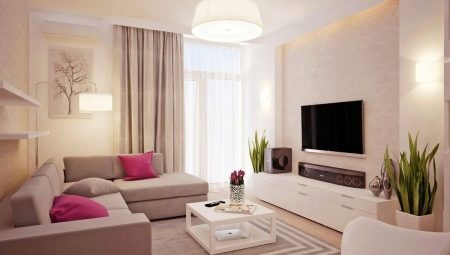A spacious apartment, a large living room are often just a dream for those who are forced to be content with a more modest footage of the home. But instead of empty dreams, you can either plan expansion, or try to make a cozy and stylish nest from your home. And most often, repairs begin with the living room, as this is the "heart" of the house.
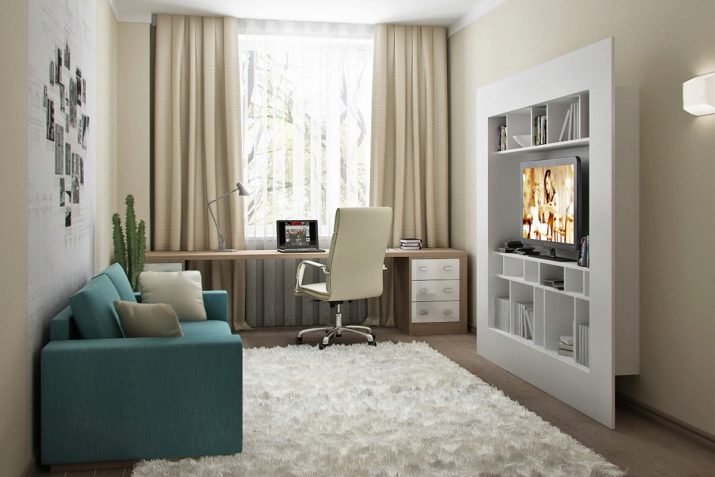
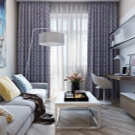
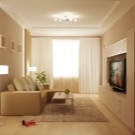
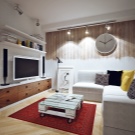
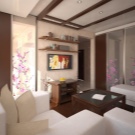

Features of the layout of the hall
There are two equivalent approaches. The first is to use all available tools to visually expand the space. Color, shapes, textures, furnishings, decor and textiles - everything is selected in such a way that the interior of the small living room does not cause any attachment to size, so that the visual space seems larger.
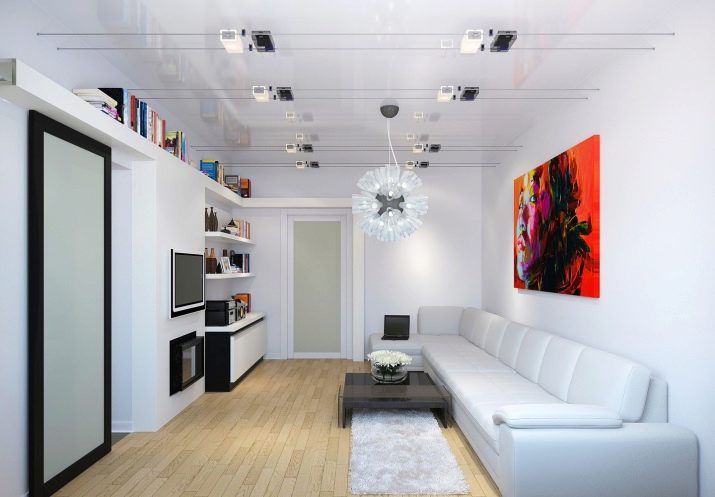
The second approach appeared (or rather, revived) not so long ago. Experts say that the time is passing when all the forces rushed to the visual methods of expanding the space. Today, a room can be dark for a small footage, and with a lot of decor and furniture, which is also not recommended for a small area.
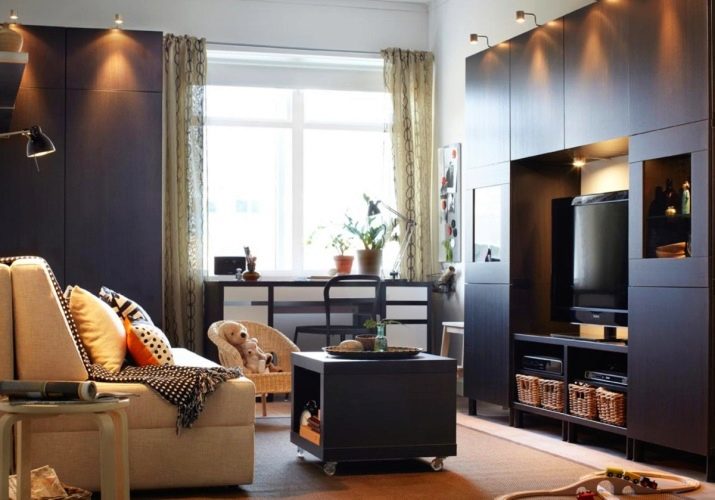
The main thing is to create an ideal, comfortable image for yourself, without regard to the prohibition of small prints, dark colors, massive furniture.
Which option for a small apartment you choose depends only on your own goals and wishes. If you want to equip a room so that it looks wider, follow the visual techniques. If you want to emphasize the small size of the living room, to make the lack of a highlight of the room, the easier.
But planning features are taken into account in both approaches.
- If the hall with a bay window, ponders how to beat this zone. Often they don’t do anything with it, decorate the bay window with overly voluminous curtains, and the great opportunity to customize the design is missed. But the bay window is a wonderful place for the dining room, a great opportunity to take out a working mini-cabinet.
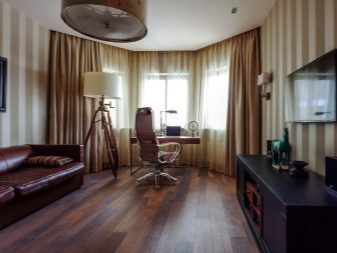
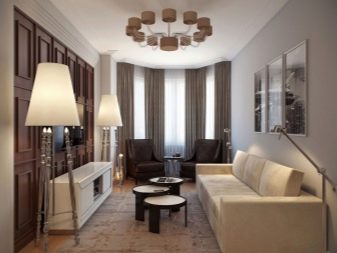
- Rectangular and narrow room of 12 square meters. m also not always rationally equiped. But with such a layout, zoning can be very successful - it is convenient to separate the dining room, library, small play area, dressing table. Especially relevant is the zoning in a studio apartment.
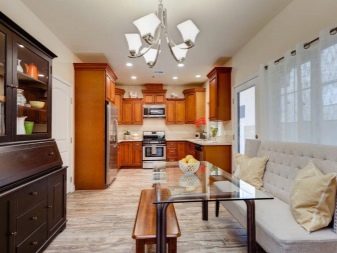
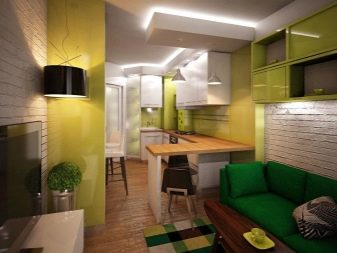
- A small living room in a house can have two or even three windows, which also affects the arrangement. It is always more successful to place a table by the window - whether it is a dining table or a desk.
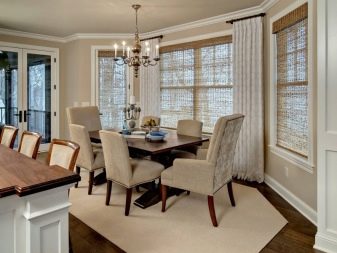
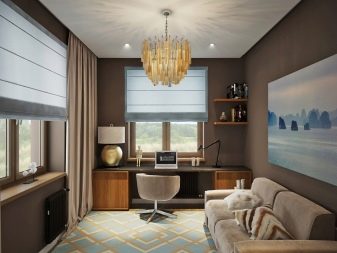
- A small hall in the country can have a sloping roof, and such an interesting layout is a good opportunity to create a Scandinavian style or retro aesthetic in the room, or perhaps to create an incredible, romantic space in the style of shabby chic.
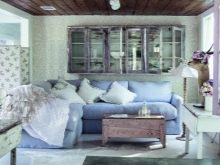

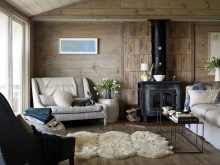
- If the living room is with the letter G, which often happens in “odnushki”, the sleeping area is usually in the corner. But if this goal is not, and the place of sleep coincides with the sofa area, then you can set a desktop in the corner by organizing a mini-office.
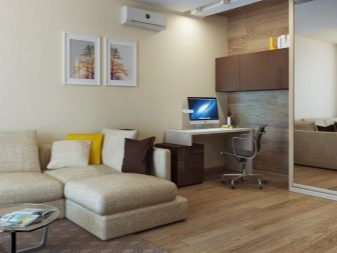
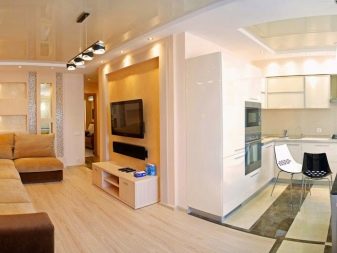
Based on the available area, a project is being drawn up. The question is being solved, which can be safely abandoned. For example, slides, sections, massive cabinets under the TV are often unnecessary. They often keep inside what the owners never take advantage of. Because the media zone can be simplified by some more interesting solution. For example, to highlight the wall with other wallpapers, laminate, imitation of a brick wall, and maybe an unexpected panel on the entire wall.
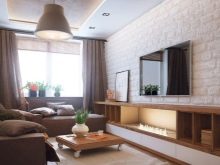
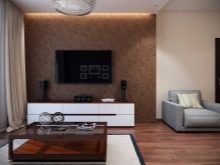
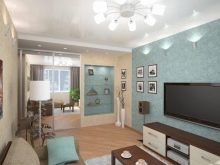
There may also be a construction with many niches and shelves, a great place for a home library, and compared to the same slide, it looks easier, more modern.
Zoning Methods
One way or another, the living room is divided into several sectors according to its functions. In one part of the room you relax, in the other you work, in the third you dine or receive guests, in the fourth children play.
And this should not be chaotic, the organization of space is important here.
There are at least 7 methods of zoning the room.
- Furniture. Sofa, shelving - these are the main furniture that helps to differentiate the sectors of the room. A sofa in the middle of a small living room will look good only if the living room is combined with the kitchen or if the sofa itself is miniature. Shelving is easier - they are end-to-end, small, not massive.
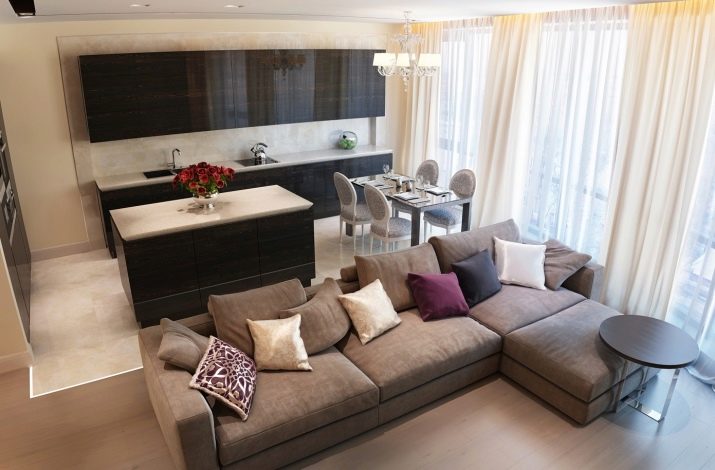

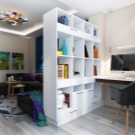
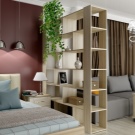
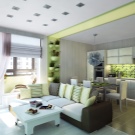
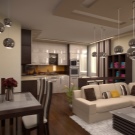
- Partitions. These can be drywall constructions of different sizes, widths, with or without niches. There are no less rare and glass partitions, which can be nominal (literally 1 m wide), and can be close to a real wall, that is, divide the room into two parts, as an interior wall would do.
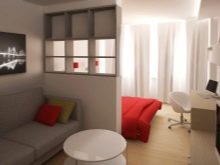

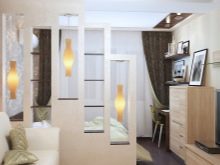
- Curtains. Fabrics and yarn curtains are another popular option for dividing space. In a small living room, they should be with an exact hit in color, not contrasting, but merging with the background. Filament curtains can separate one zone from another with a continuous partition. Fabric curtains - this can be a well-tight, dense material that is securely fixed in two holders (upper and lower).
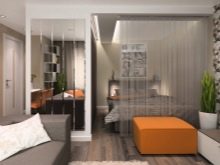
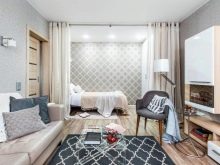
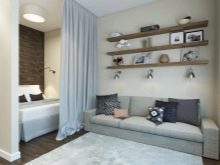
- Wallpaper. Wall decoration can also mean dividing the space into zones. This is especially often used in the visual separation of the recreation area from the dining area.
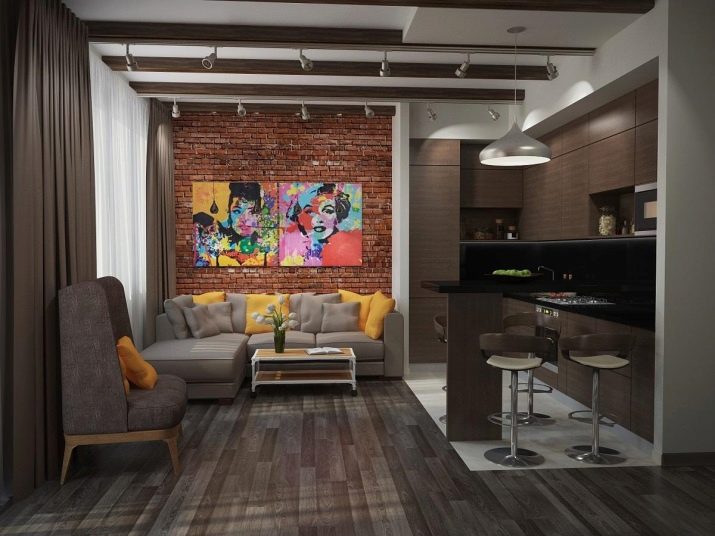
- Carpet. It may seem surprising, but wall-mounted carpets are returning to interior fashion again. However, it’s worth starting with the floor: there can be a relaxation area (sofa, table) on a wide large carpet, and the open floor speaks of the designation of another sector.A rug vertically hung on a wall may indicate a dining area.
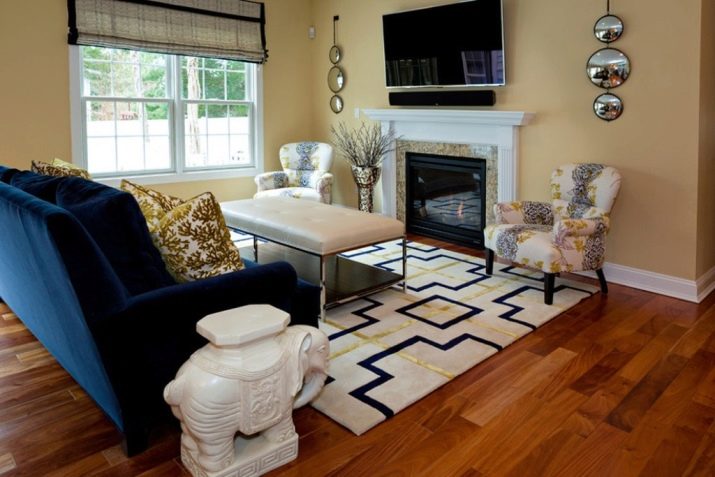
Only not every carpet can handle this: fashion today is in demand for high-quality cotton products with an ornamental pattern in the style of boho.
- Ceiling. The elaborate ceiling is a controversial solution for a small living room. But the division of zones by different design sections of the ceiling surface still occurs. A compromise solution is the installation of spotlights over one of the zones (dining room, for example).
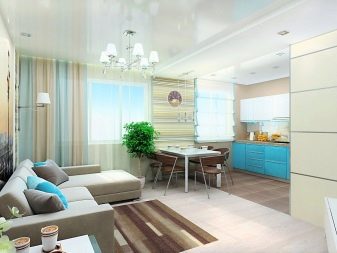
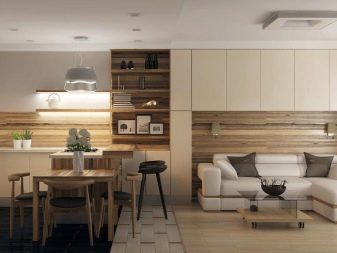
- Podium. A fair solution for a small room, but with the condition that the ceilings in it are not low. In the podium, you can organize additional storage and even equip a bed there.
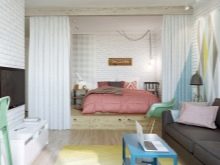
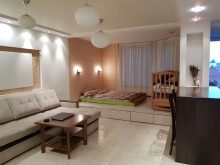
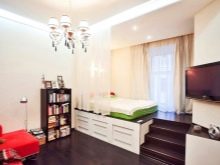
How to specifically zon the area depends on the number of zones allocated in it. In most cases, the finish is enough. Massive partitions and furniture in the middle of the room often look unsuccessful in practice.
Style solutions
Design in a classic style does not cease to be in demand. But the basic requirement for such a repair is invariable: a classic-style living room is expensive natural materials. It is impossible to imagine a situation in which a wallpaper in a classically designed living room after a couple of years lost its luster and needed to be replaced or that the furniture lost its presentable appearance. In addition, the design of the hall in the classical style requires space, and a small footage will be an obstacle.
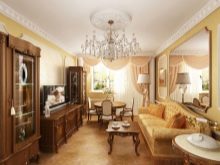

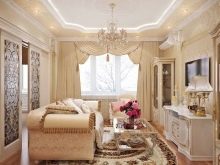
Modern classics are more compliant in this respect: in some places it is allowed to replace a valuable array with MDF; it is not necessary to purchase furniture with complex facades.
Other styles for decorating a small living room.
- Boho. A very popular style, which is aptly called the embodiment of the holiday of life. There is no room for gloomy tones (which is very suitable for a small room), the color scheme is bright, and the boho style is very demanding on the decor. But even in this style there should be a dominant, initial style from which boho will be molded. Someone prefers to start from the country, someone from the Nordic style.
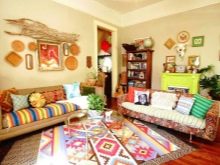
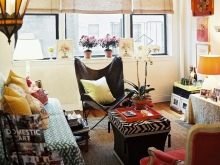
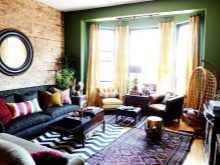
- Scandinavian. Great choice for a small room. These are bright spaces with the most open layout and modest window decor. The style is no frills, even the decor is not accidental. This is a great destination for those who love change. Changing the decor, you always get a new room.


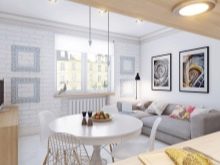
- Pop Art. We cannot but mention the style that will suit creative people who are bored in the same type of interiors. It exploits contrasting, vibrant hues; neon inclusions are possible in it. The main semantic load in this style are the walls.

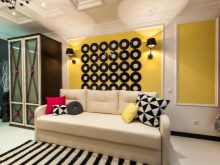
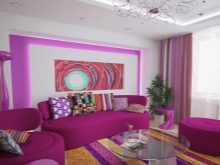
- Art Deco. Something between functionalism and modern. The style is subject to strict patterns, softened by ethnic motifs, geometric and floral patterns. It combines a rational structure and elegant forms. The room does not appear in the form of a single composition, but rather represents a collection of stylish objects.
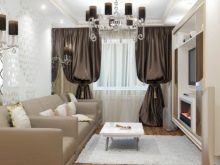
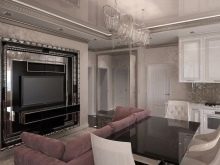
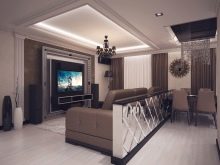
- Japanese style. It features a soothing and concise design with a streamlined environment, as well as a tendency to recreate natural conditions. Only natural materials are used, light wall decoration, furniture in limited quantities. If you are not going to “load” the living room with many features, the Japanese style is worth considering.
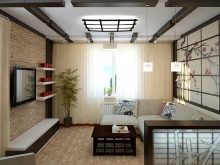

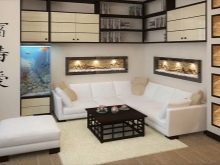
- Minimalism. Its occurrence is due to the merger of the concepts of Japanese style and constructivism. It was once considered the antipode of bourgeois luxury. It involves simple forms, neutral tones, small volumes. The interior in this style will be calm and restrained, not a single extra object in it.
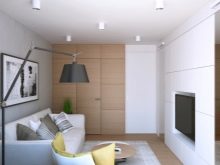
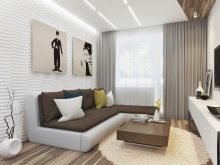
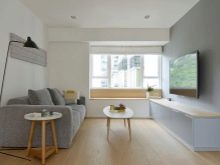
- Kitsch. This style mixes different directions, incompatible details and colors. Its main difference is redundancy in everything. Representatives of creative professions, as well as those who do not like stereotypes, can arrange such an interior in a small living room.

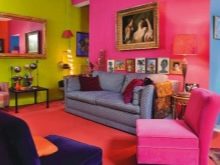
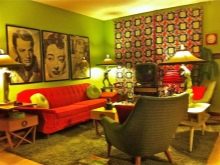
- Eclecticism. Another bold direction - within its borders it combines two or three other styles, similar in essence. Without a designer, embodying eclecticism in a small living room is risky.
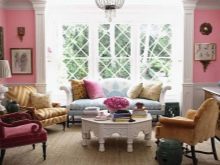
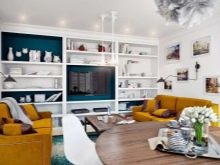
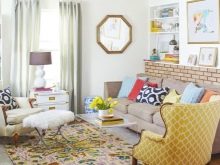
- Shabby chic. The style of Victorian romance, in which vintage and artificially aged things coexist, creating a romantic cozy interior. This is a gentle style with an imprint of nostalgia for a beautiful past.
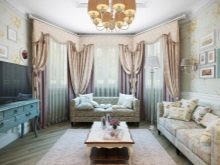
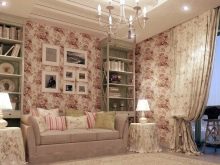
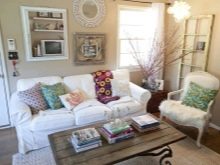
- Provence. French country dominated by natural materials, light furniture (ideally vintage), muted tones and elaborate lighting.
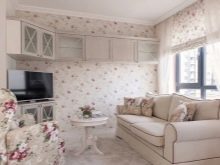
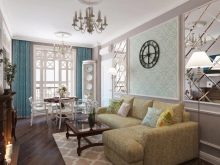
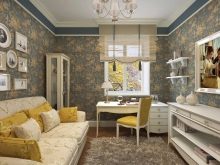
Separately, it is worth noting the modern style, or Contemporary. It appeared in the middle of the last century, it is based on Scandinavian interior motifs, constructivism and minimalism.
And if your room is small, then this is fertile ground for contemporary style. It is laconic and restrained, but at the same time does not refuse decorativeness. Usually decorate his things, which are produced by mass production, the decor is typical and recognizable.


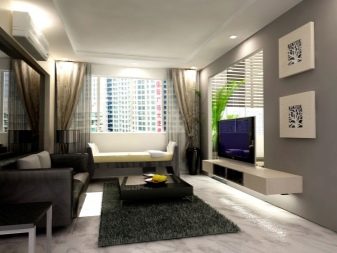
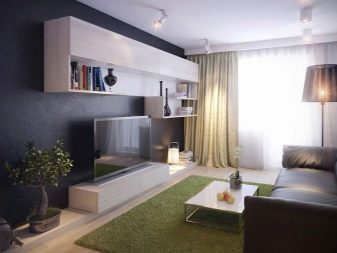
Simple shapes, practical solutions, complete freedom in the choice of materials, decor, colors are inherent in the modern style. Smooth shapes and clean lines - this is the basic concept of modern style.
Color spectrum
The advantage, of course, is on the side of bright colors. For a small room, this is the optimal solution, and if the room is the only one in the apartment, then making it dark or colorful is very risky. You can decorate the living room in monochrome colors, without coloristic transitions and bright solutions. Usually they prefer white color, which is the best background for almost any environment.


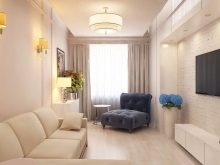
You need to be able to play with colors: for example, a dark floor combined with light walls and a ceiling makes the room visually more spacious. A light front wall and dark side walls seem to deepen the living room.
In addition to white, for visual expansion of space, they are suitable:
- beige;
- blue gray;
- light green;
- faded pistachio;
- faded lemon;
- delicate olive;
- diluted with milk taupe.
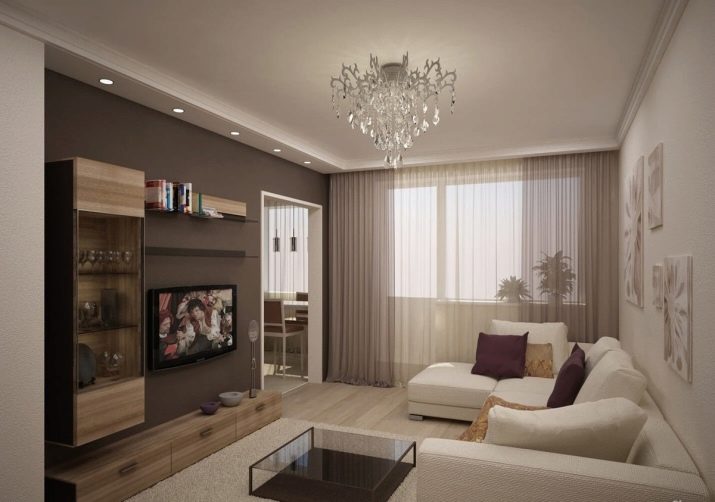
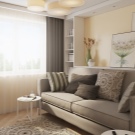
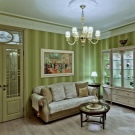
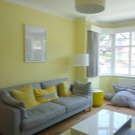
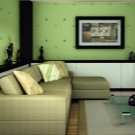
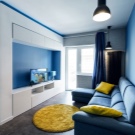
Large print and small print are undesirable. Only if it is an accent wall can you afford such expressive wallpaper.
If the interior is classic, the best choice would be brown-coffee and milk tones.quite suitable for a small living room. Sand and golden hues can also be a good choice.
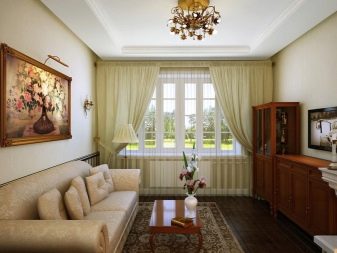
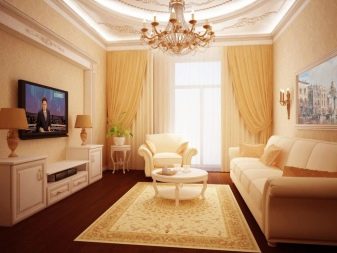
If the hall is a checkpoint, then one dark wall and three light ones will make it more comfortable and stylish. Mirrors are hung on light coatings.
Wall, ceiling and floor decoration
Walls are the main backdrop of a small living room. If the wall decoration is correct, they will not become an annoying element in the room. Smooth wallpaper or painting wallpaper for a small space is optimal. You can completely abandon the wallpaper, preferring them to painting. Occasionally, thin plastic panels are used in the living room. Fragmentally acceptable artificial stone finish.
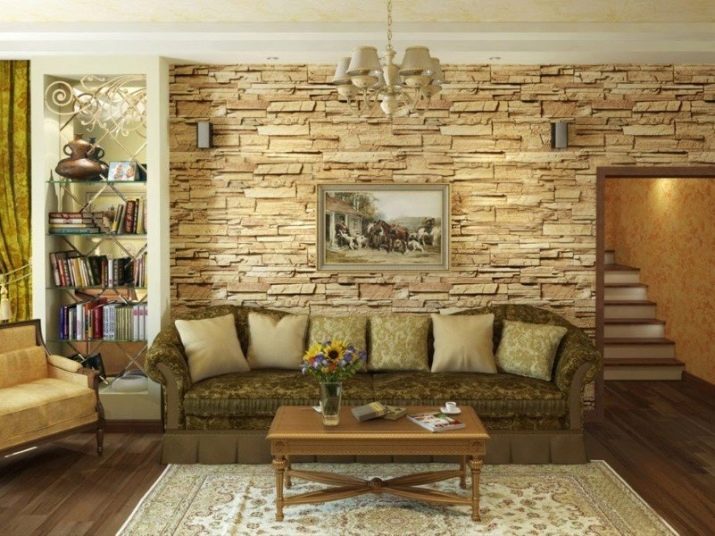
Coatings that imitate brick or masonry, in principle, look interesting in the living room, ennoble it. The walls can be equipped with mirror or glossy elements, sometimes they are perfectly complemented by spot lights. If there are photo wallpapers with a perspective image or interesting 3D wallpapers on the directly located central wall, this will also visually expand the room.
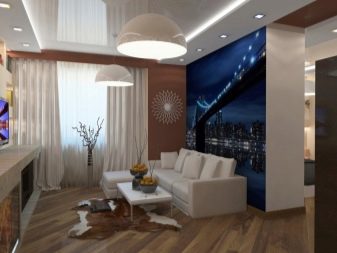
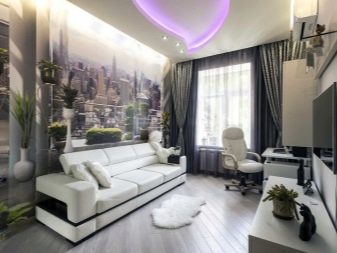
The floor in small living rooms is most often made light, ideally it is parquet or parquet, but today there are many budget options (the same laminate) that will become a compromise solution. A bright carpet makes the room more comfortable, but it is very demanding in care. A glossy bulk floor will also be a good modern solution, but this is an expensive service and not everyone considers it comfortable.
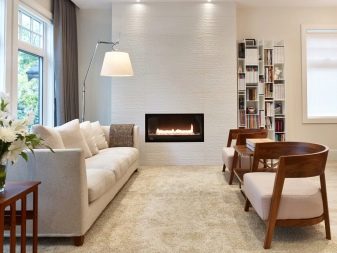
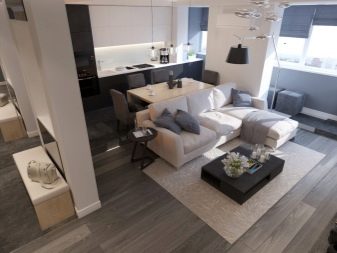
As for the ceiling decoration, two options are leading - alignment and painting or stretch ceiling. The first option is simpler, cheaper, more environmentally friendly.Today they prefer the second more often, but experts are sure that this mod will not be long. People will come to understand that a neat white ceiling after painting is both concise, simple, and harmless.
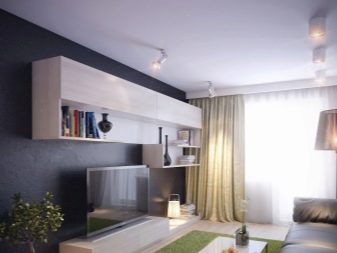
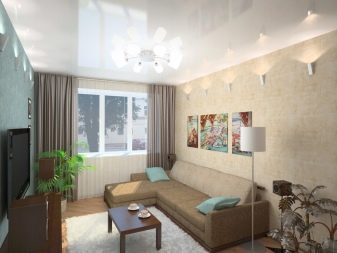
But it is better to refuse plasterboard structures in a small room: they burden the appearance of the room.
Choice of furniture and curtains
The amount of free space depends on the furniture. This means that the furniture must be arranged so that everything you need is at hand. Functionality above all. Large twin armchairs, no matter how much they would like, do not look in the mini-living room. But transformable functional furniture is optimal for a small room. Particularly successful are modular sofas and armchairs that combine well.

Tables and chairs are often also used folding. The sofa is located in the central zone, its upholstery should coincide with other elements of the interior. A compact leather sofa can be a great practical solution. An average table and one armchair (very compact) are usually placed next to the sofa.
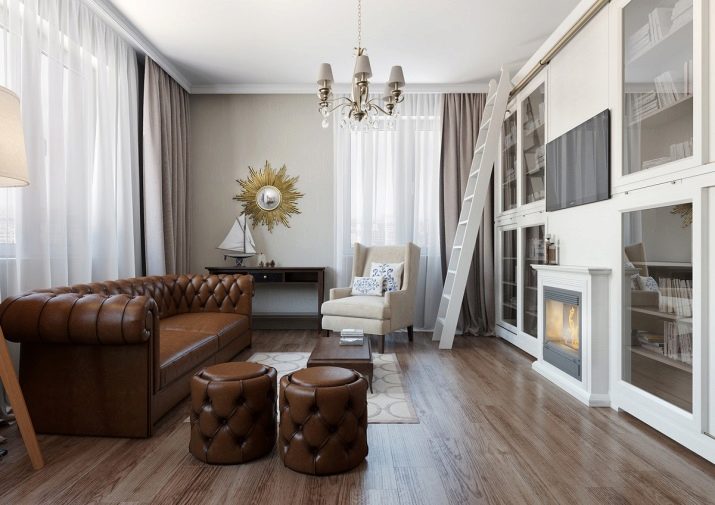
It’s better not to put large furniture near the window, so that the room is filled with light. But tables, not higher than the windowsill - are perfectly acceptable. If there is a piano in the room, then free the area of the room from the chest of drawers or from furniture of similar height.
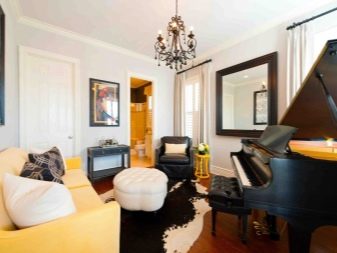
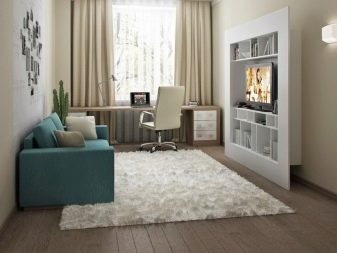
Near the sofa, by the way, you can place a small nightstand, under which there is a small pouf. It can be hidden at any time for freedom of space.
In addition to the need to furnish a room, you also need to arrange a window. Yesterday - too lush, especially glossy curtains that create a lot of waves. They look ridiculous in a space that does not correspond to luxurious, demanding to chic styles, and certainly do not combine with the small footage of the room. You can stay only on the tulle - white frosty, with a simple pattern. But you can supplement it with active curtains that are combined with the second most important color in the living room.
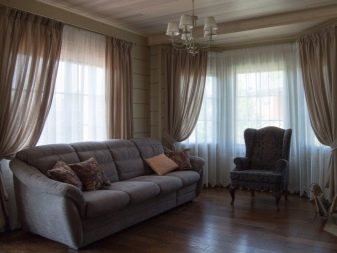
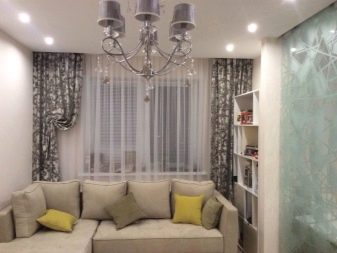
Lighting
Light - natural and artificial - the most important element of the living room. If you need more natural light, then this is solved by a window with a minimum of partitions and light tulle. But with artificial lighting more options. One massive chandelier is becoming obsolete today as the main lighting element. Paradoxically, it can become the most massive element in a room.
Designers advise to abandon the central chandelier in the living room in favor of a pair of small lamps or sconces that are placed in the functional areas of the room. And this turns out to be a more valuable solution: rarely is light needed absolutely everywhere.
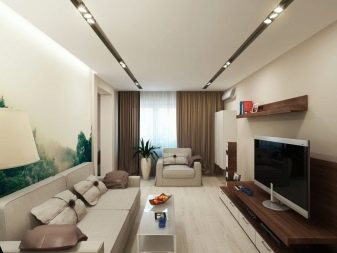

It is more logical to highlight separately the media area, work area, and dining table.
Decorative elements
If the space is cramped, preference should be given to decorative elements tending upwards - high elongated figurines and vases. Useful and “airy” glass shelves. Many small decorative details create a sense of chaos, clutter, so leave only that which organizes the space in the room, and does not divide it.
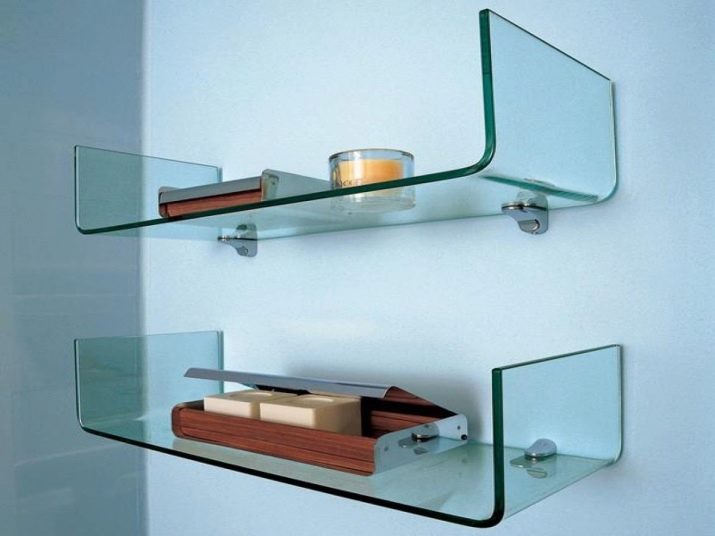
The picture on the wall is a classic decor. It can be abstract, not bright and not colorful, and often such paintings combine the two main colors of the living room. Such decor as macramé panels is also in fashion today.

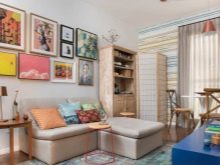
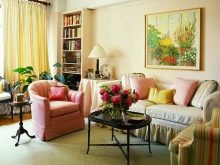
Any hand-made decorative products (a composition of branches, for example) will be a valuable addition to the interior, an element of individuality in it.
Beautiful ideas
An eloquent addition to the above will be examples of well-designed small living rooms. For comparison, in the selection of photos of rooms solved in different interior styles.
10 beautiful little living rooms.
- A fragment of a bright, frills-free boho style living room. Everything is very soft, gentle, natural, the room is freed from massive details. Summer lives in it and a lot of air is in it.
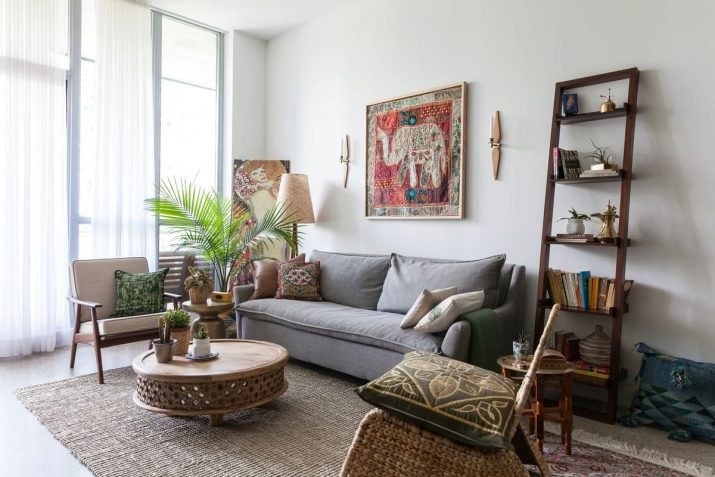
- The small Provencal-style hall is very romantic, light, and elegant. Furniture with high functionality (many storage locations) looks exquisite. The main thing in such a living room is not to overdo it with the decor.
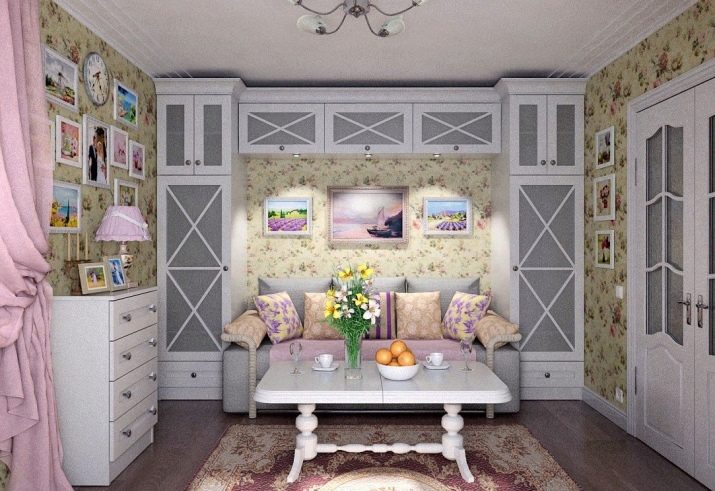
- Noble living room in the style of modern classics - this is the decision on which households most often converge. Note that the furniture is not selected from one set, which designers often talk about today.
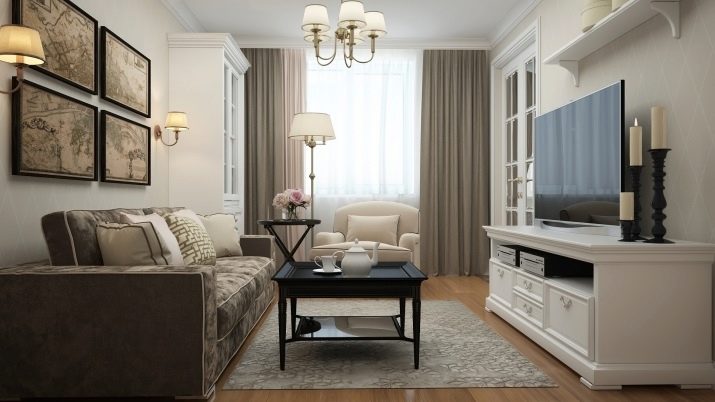
Do not be afraid to mix heterogeneous furniture, it looks more lively and relevant.
- An attempt to recreate an art deco style on a small footage. Glossy surfaces, glass are well selected. Successfully moved to the window desktop. The dark floor is in harmony with the light walls. It is important here not to make a mistake in the selection of furniture, it should correspond to the style.
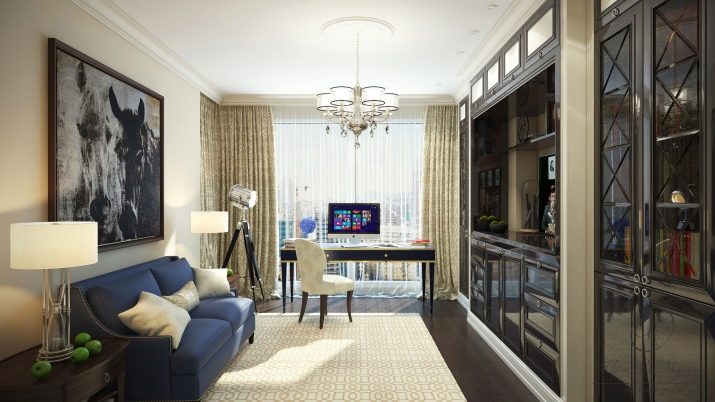
- Something between scandy and fusion, for an elongated living room is a very good option. The dining area is beautifully beaten, color rollouts are also successful, a reference to retro makes the space cozy and vibrant.
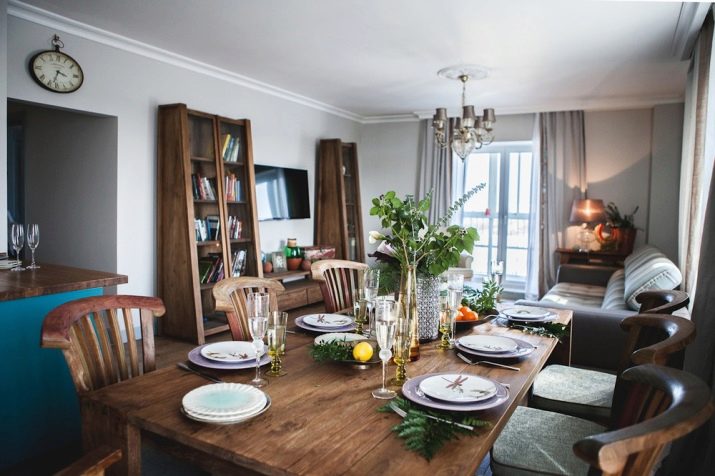
- Option living room, which is the only room in the apartment. The inspiration is taken from the Scandinavian aesthetics, but the style is not sustained in its purest form. However, everything fit in the room: massive furniture, a large sofa, and an original table. The alleged third wall may have either a dining area, or a piano, or a corner for a child.

- This may look like minimalism. Accent geometricity, lack of bright colors and smooth perception of space look soothing and, of course, stylish.
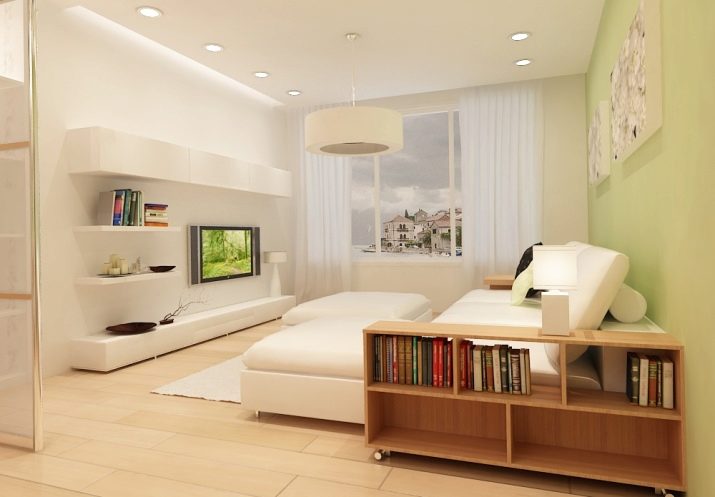
- Part of the living room in fusion style. If you are bored of calm, harmonious interiors and want a sharp style, taste of life - then take a look at such decisions. They accurately emphasize a certain exclusivity of the owner.

- This style cannot be clearly defined, but the room is undoubtedly charming. Lovely finishes, beautiful furniture and everything is very affordable.

- A stunning eco-style solution. The fireplace can be decorative, but otherwise everything is very concise and cute. Nature enthusiasts should appreciate it.
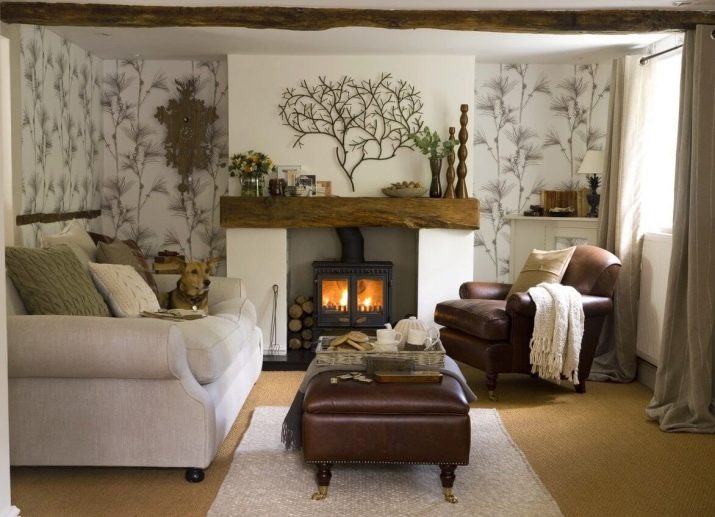
Do not be afraid to choose, do not immediately cut off bold ideas. The apartment is a kind of reflection of the owner, so let it not be boring!
See how to arrange furniture in the living room in the next video.
